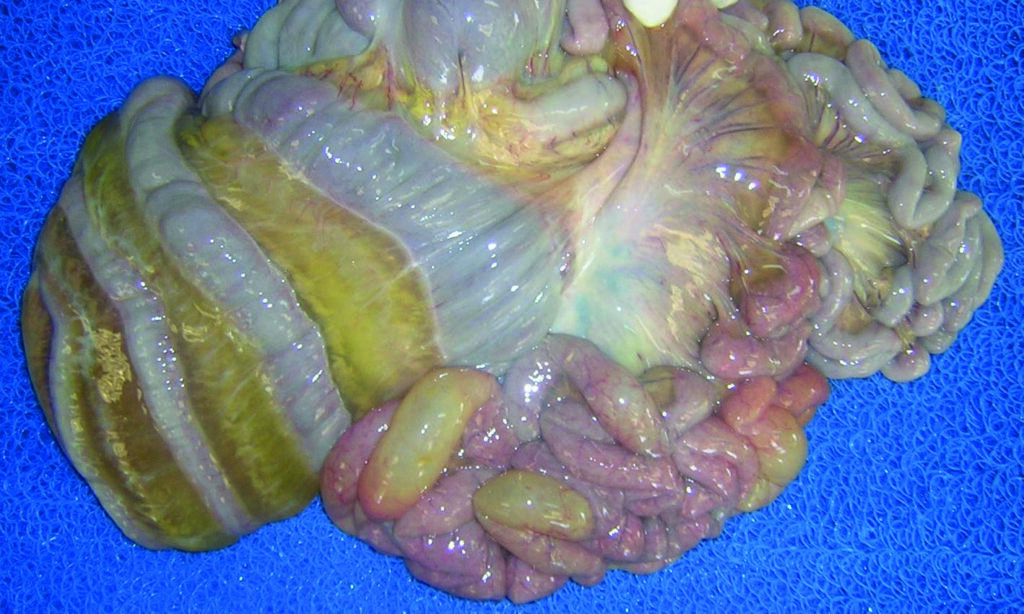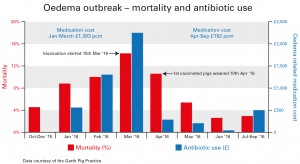Vaccination against bowel oedema has saved a large-scale, high-performing pig unit thousands of pounds due to lower mortality, improved growth rates and reduced medication costs in post-weaning pigs.
The 730-sow herd in the north of England was weaning around 29 piglets per sow per year when the problem struck. Monthly post-weaning mortality began creeping up and peaked at 14 per cent in March 2016.
“Sick pigs were wobbly or recumbent and fitting with puffy eyelids. This tended to occur about three weeks after weaning, in a relatively narrow ‘window’,” said the farm’s veterinary surgeon Paul Thompson, of Garth Pig Practice.
Bowel oedema was diagnosed through post-mortem examination, though not all pigs showed the classical oedema between the loops of the large bowel.
“It can be difficult to definitively diagnose bowel oedema. However, the farm was also known to be strep meningitis positive, which has some clinical similarities,” Mr Thompson said.

Cultures were submitted for laboratory testing, known as STEC-Check, funded by IDT Biolologika and carried out by SAC at Edinburgh. These were typed as positive for E. coli virulence factors F18 and shigatoxin, which causes clinical signs seen in bowel oedema, but not all isolates were positive for both factors.
“Bowel oedema can be difficult to confirm on STEC-Check test and multiple samples may be required to reach a diagnosis,” he said.
Initially, treatment was through antibiotics including colistin – not under restriction at the time – neomycin and florfenicol, mostly orally. No significant response was seen despite water-flow rate, feed regimes and hygiene being considered satisfactory.
All piglets were vaccinated with Ecoporc Shiga, supplied through Hysolv Animal Health, at four days of age, but some older pigs had, initially, to be vaccinated to reduce the time-span for the vaccine to impact.
“When the vaccinated pigs entered the system, the first batches passed the risk period with much lower mortality,” Mr Thompson said.
In fact, an analysis by pig industry consultant John Richardson showed that, by three months after vaccination was introduced, average post-weaning mortality fell to 2.5 per cent. Medication costs were also reduced, from an average of £1,393 per month to just £192.
The reduced mortality – 4.4 per cent – meant that 108 extra pigs per month were produced. The value of these pigs, at 25.8kg, was put at £5,618, a net benefit of £7,288 per month, when taking into account reduced medication costs. In addition, an improvement in growth rate, from 373g to 409g per day, meant an extra 5,062kg of live pig weight was produced, worth £3,949 per month at 78p/kg liveweight.
“After years of the disease being a textbook rarity, we are not encountering bowel oedema on a regular basis“
As labour was considered a fixed cost, no extra expense was allocated to the physical task of vaccination.
Mr Thompson said: “Our client considered the vaccine highly effective.
“Oedema is now a re-emerging problem across Europe. After years of the disease being a textbook rarity we are now encountering bowel oedema on a regular basis. The causes for this re-emergence are not clearly understood. The disease can be frustrating to diagnose, as not all cases present the classical oedema of the bowel symptoms and proving the presence of the causative agent can require multiple samples.”
The drive to reduce antibiotics in livestock production and the possible withdrawal of zinc oxide from diets could reduce a vet’s armoury against a variety of diseases, Mr Thompson concluded. “Vaccination is certainly preferable to using medication as a control.”





